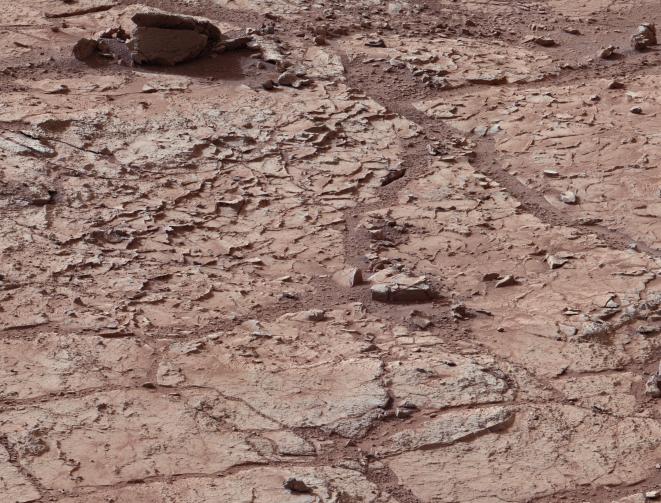Curiosity Rover Gets Ready To Drill Into Mars For The First Time
Nobody has ever tried anything like this on Mars before.

A flat rock with pale, veiny fissures could be the first thing the Mars rover Curiosity drills for a sample of the Red Planet, NASA scientists said Tuesday. It’s the most challenging task yet for the intrepid car-sized rover (after its landing). No spacecraft has ever penetrated a rock on Mars.
The drill is a cornerstone of the mission, able to breach the surface of interesting-looking rocks and determine what their insides contain. It can drill about 5 millimeters into Mars, which is enough to get some aspirin-tablet sized samples of dust for the rover’s instruments to ingest. The goal is to find out whether Mars could have ever been hospitable for life, and understanding the formation of Mars rocks will help answer that question. It’s taken the rover team quite a while to pick out a suitable sample, in part because they keep finding their rover surrounded by so many interesting things.

Rocks Of Many Types
“It does take us a while to do stuff; that’s a product of the fact that this mission is so complex, there are a lot of different things to do, and there’s a lot of interesting things to look at,” said Richard Cook, the Mars Science Laboratory’s project manager.
In the past few weeks, Curiosity has been stationed in a region called Yellowknife Bay, which features fractured ground with different temperature swings compared to other nearby terrain. The rover’s cameras have spotted veins, blueberry-like nodules, layers and even a rare “Martian flower,” which is actually just a shiny pebble embedded in sandstone. The zone where Curiosity will drill has been dubbed “John Klein,” for a deputy project manager who died in 2011. There’s an embarrassment of riches when it comes to possible targets–Cook called it a “candy store.”
It will mean plenty of opportunities to test new hypotheses, said John Grotzinger, Curiosity’s project scientist. “We chose to go there because we saw something anomalous, but we wouldn’t have predicted any of this stuff from orbit,” he said in a news conference Tuesday. “We can’t wait to get drilling on this stuff.”
The rover’s suite of other instruments has been doing the initial reconnaissance, including several laser blasts with the ChemCam spectrometer. ChemCam has been seeing signs of possible gypsum, or other hydrated calcium sulfates. That means there was likely water in those fractures. Drilling into them will provide more answers, Grotzinger explained.
“What we are hoping to do is sample the main filling material as well as what we call the ‘country rock’ around it, to get a sense of the mineralogy,” he said.
Curiosity will spin its drill bit for the first time probably in about two weeks, according to Cook. The team will probably take its time sampling the rover’s current parking spot before sending it to the base of Mt. Sharp within Gale Crater, its ultimate destination.